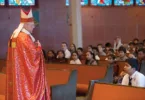
by Dean Backes
KANSAS CITY, Kan. — In order to bring an extra layer of protection here to the fight against COVID-19, influenza and other viruses, Bishop Ward High School facilities director Richard Williams is going high-tech.
Tasked with finding a solution for disinfecting and sanitizing classrooms, Williams’ maintenance man Anthony Taylor located a self-propelled robot that wanders from room to room exterminating microscopic airborne pathogens.
“I think it’s going to be an amazing tool for us to mitigate a lot of the influenza, COVID-19 and other viruses that can be passed along in a school,” Williams said of his new germ-fighting toy. “It keeps kids in class and gives teachers the ability to be that much more effective in their teaching.
“That’s why we got it. To be able to help our kids and really foster that learning experience.”

Using grants that were available to the school through the CARES Act for the specific purpose of helping a school promote an environment that limits the spread of disease, school officials purchased its Adibot through UBTECH, a global robotics and AI technology company.
Armed with Simultaneous Localization and Mapping technology (SLAM), Williams’ new tool creates its own floor plans and then navigates autonomously within them. The robot can also be controlled remotely.
“It can go from room to room,” Bishop Ward president Jay Dunlap said. “If you give it a map, it can navigate by itself. As long as you have the doors opened, it will go in the rooms and, using ultraviolet light, will kill viruses that are airborne pathogens, such as coronavirus.
“I guess you’d say the opportunity presented itself because of the funds available, the specific purpose for those funds and the fact that we learned about this machine.”

According to the company’s website, Moe — as he is known by students and faculty through a naming contest — has intelligent safety features that ensure the smooth running of the programmed disinfection routes.
Since the robot uses UV-C rays to break the reproductive chain of viruses, Moe is equipped with risk-reducing cameras, PIR sensors that detect human movement via body heat, acoustic warnings, sensor-controlled safety signs, an emergency remote control with stop button and an emergency stop switch.
Moe provides 360-degree radiation coverage, and its 16 UV-C lamps effectively disinfect 99.9% of the rooms he enters. The robot is optimally used in medical facilities, hospitals, dental practices, hotels, offices and fitness centers.

The first school in the region to purchase an Adibot, Bishop Ward is a pilot program for UBTECH and robots like Moe in Kansas, Nebraska and the surrounding area. After Bishop Ward purchased the robot, UBTECH representatives walked Williams and Taylor through the robot’s programming, its sensors and all of the hardware that is required to keep Moe running.
Since Bishop Ward consists of three floors and has no elevators, the robot has been sanitizing the first floor while Williams looks for a way to transport the robot to the other two floors. Once a solution is discovered, Moe will be put to work sanitizing a different floor every night.
The robot has a circular light at the top that signals “green” when it is safe for students and faculty to cross his path. If the robot is disinfecting when a student or faculty member walks into the room, Moe will automatically pause until it’s safe to continue. If a student or faculty member sneezes or becomes ill, Moe can be brought in to extinguish any germs that may be left behind.

Students, faculty and passersby can view the robot while it is working through a glass window because Moe’s light cannot penetrate the window. However, anyone that encounters a working Adibot without that protection may suffer symptoms similar to a sunburn or receive injuries to their eyes.
While he may not be able to serve up a hot, delicious breakfast, Moe, who was named after a similar character in the 2008 Disney-Pixar animated feature film “WALL-E,” is quite capable of battling germs and viruses and keeping kids in school.
“Clearly, I think we’re all interested in doing what we can to get the environment as healthy as possible,” Dunlap said. “This seems like a mechanism that will help.”






